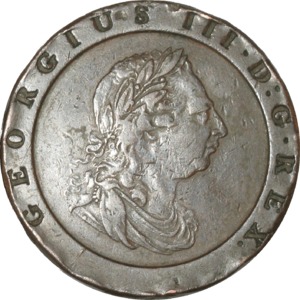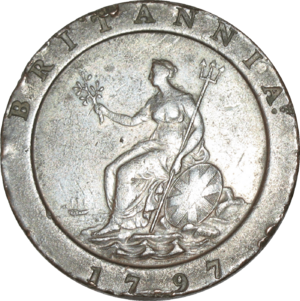Twopence (British pre-decimal coin) facts for kids
| United Kingdom | |
| Value | 2d sterling |
|---|---|
| Mass | 56.7 g (2 oz) |
| Diameter | 41 mm (1.6 in) |
| Edge | Plain |
| Composition | Copper |
| Years of minting | 1797 |
| Mint marks | SOHO, below and to the right of Britannia. |
| Obverse | |
 |
|
| Design | Profile of George III |
| Designer | Conrad Heinrich Küchler |
| Design date | 1797 |
| Reverse | |
 |
|
| Design | Britannia |
| Designer | Conrad Heinrich Küchler |
| Design date | 1797 |
The British twopence (often called 2d) was a special coin from the United Kingdom. It was worth two pennies, which was a very small part of a pound. This copper coin was only made for a short time in 1797 by Matthew Boulton's Soho Mint.
These coins were officially allowed to be used for payments up to one shilling starting in July 1797. Later, some silver twopence coins were also made in 1817, 1818, and 1820. The twopence coin stopped being used in 1860 when new bronze coins came out. The copper twopence was the biggest and heaviest copper coin ever used in Britain.
Contents
Why Was This Coin Made?
For many years, the British government had stopped making silver pennies because silver had become too expensive. By the late 1700s, there weren't enough pennies for people to use every day. Because of this, many businesses and mining companies started making their own unofficial copper tokens (like coins). For example, the Parys Mining Company in Anglesey made a lot of these tokens.
In 1797, to help with the coin shortage, the government asked Matthew Boulton to make copper pennies and twopence coins at his Soho Mint in Birmingham. It was important that the value of the coin matched the value of the metal it was made from. So, each twopence coin was made from two pennies worth of copper, which was about 2 ounces. This made the coins much bigger than older pennies.
The "Cartwheel" Coins
Because of their large size and thick edges, these coins were nicknamed "cartwheels." All "cartwheel" twopence coins have the date 1797 on them. About 720,000 of these coins were made in total.
By 1802, companies had stopped making their own tokens. However, over the next ten years, the copper itself became more valuable. People started melting down the government's copper coins to sell the metal, and private tokens began appearing again by 1811. To fix this, the Royal Mint started a huge program to make new coins in 1816. They made many new gold and silver coins. In 1817, a new law was passed that made it illegal to make private tokens, with serious punishments for anyone who did.
A small silver twopence coin was also made for a short time, in 1817, 1818, and 1820. After that, silver twopence coins were only made as special Maundy money.
New Coins for Britain
A few years later, Thomas Graham, who was in charge of the Royal Mint, convinced William Ewart Gladstone, the person in charge of the country's money, that many old copper coins needed to be removed from use. He suggested making completely new coins that would be "much more convenient and agreeable." New bronze coins were introduced in 1860. These new coins did not need to have the same value as the metal they were made from. The old copper coins started to be taken out of circulation a year later.
What Did the Twopence Coin Look Like?

The 1797 copper twopence coin weighed about 2 ounces and was about 1.6 inches across. The front of the coin, called the obverse, showed a picture of George III facing right. Carved into the edge of the coin were the words "GEORGIUS III·D·G·REX". The letter "K" can be seen on the lowest part of the king's clothing, which shows that the design was made by a German artist named Conrad Heinrich Küchler.
The back of the coin, called the reverse, was also designed by Kuchler. It showed a figure of Britannia sitting and facing left. She held a trident (a three-pronged spear) in her left hand and an olive branch in her right hand. There were waves around her feet, a small ship to her left, and a Union Jack shield below and to her right. The word "BRITANNIA" was carved into the top edge, and the date "1797" was on the bottom edge. The word "SOHO" appeared next to the shield, showing that the coin was made at the Soho Mint.
Nicknames for the Twopence
"Tuppence," sometimes shortened to "Tuppy," is a nickname often given to a young child. You might know the fictional detective Prudence "Tuppence" Cowley, or the actress Tuppence Middleton, who got her name from her mother's childhood nickname.
This nickname might come from how small the coin was when it was used as Maundy money after the 1820s. It might also be because the coin was quite rare. It was first made in 1797 as a very large "cartwheel" copper coin. After that, it was only made as Maundy money, which was a rare and very small silver coin mostly given away by the monarch. Only a few thousand of these special coins are made each year by the Royal Mint.

